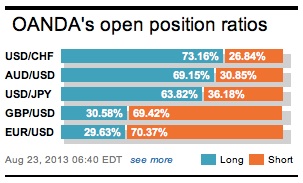All week the ‘mighty’ dollar has been following yields – higher US rates suggested a stronger greenback as investors shunned risk in emerging countries. Outflows from emerging market bonds and equities funds accelerated on expectations that the US Fed will start withdrawing stimulus measures. This has led investors to fold their bets on a larger scale. In the overnight session, the moderation in the US 10-year treasury yields to +2.89%/2.91% range is seen as a support for risk assets across Asia.
The forex market does not have the time to sit on its laurels, if anything, it’s about to grab its second wind as there happens to be too much event risk involved in the market place over the next six consecutive weeks. Investors are faced with federal election down-under and in Germany, the market expects a decision on the Japanese consumption tax, if Japanese growth is affected JPY will be in demand, NFP and the FOMC taper decision to name but a few events that will keep global markets on their toes.

The Asian Emerging Market FX has stabilized, with the dollar Thai baht and Malaysian ringgit trading off their highs. One of the bigger movers of the week, the dollar Indian rupee has managed to open lower, but the Indonesian Rupiah continues to trade on the weaker side, ahead of Indonesia’s policy package announcement. The rest of G10 could be described as mostly treading water, with the 17-member single currency confined to its pre-FOMC minutes tight trading range.
Emerging governments and Central Bankers are trying, currently in vain, to stop the flight of foreign capital out of their markets and into the dollar. One of the instigating currencies has been the INR. Overnight the Indian government held a press conference to reassure investors that the rupee was “undervalued.” Their Finance Minister, Chidambaram, emphasized that there is no intention to introduce any type of capital control, including controls on repatriations – the rupee is undervalued, and has overshot appropriate levels. The RBI published annual report highlights the importance to preserve “macro financial stability as the prospect of reduced US Fed stimulus contributes to a slide in the rupee. Emerging economies are concerned by the twin threat of higher consumer “inflation” and their ever-increasing “current account deficits” that exceeds sustainable levels – this all leads to slowing growth and hot money looking for an exit!

The rating agency Fitch said in a statement yesterday that “policy management will be the key factor in determining whether economic and financial stability is maintained in India and Indonesia following the intensified pressure on currencies and asset prices.” These pressures have exceeded those of other emerging Asian economies, but Fitch Ratings does not view these developments as a trigger for rating action at this point. The ratings already incorporate both “recognition of vulnerabilities and some tolerance for volatility in market conditions.”

Capital markets are to remain volatile and uncertain in advance of decisions by the Fed. The majority of market analysts firmly believe that the Fed will begin tapering as early as next month. What about the global investor? Have they already priced in that expectation? Data this morning confirms that the UK economy grew more than previously thought in Q2 (+0.7%). Elsewhere, the final release of Q2 GDP figures for Germany confirmed earlier estimates, while in China; manufacturing activity this week suggested signs on stabilization. However, despite the plethora of better news, the various asset classes stays on tenterhooks, as investors remain concerned over when the Fed will actually begin to rein in its $85b a month bond-buying program. The threat of less accommodation continues to put a premium on liquidity of emerging market asset classes. It seems that both ‘hot’ money and the global investor is done with emerging markets. The shifting of assets and rebalancing of portfolios will not be completed until after the Fed’s tapering actually begins. Until then, heightened volatility remains the order of the day!

Other Links:
FX In ‘Fight Or Flight’ Challenge As EM Stumbles
Dean Popplewell, Director of Currency Analysis and Research @ OANDA MarketPulseFX
This article is for general information purposes only. It is not investment advice or a solution to buy or sell securities. Opinions are the authors; not necessarily that of OANDA Corporation or any of its affiliates, subsidiaries, officers or directors. Leveraged trading is high risk and not suitable for all. You could lose all of your deposited funds.


